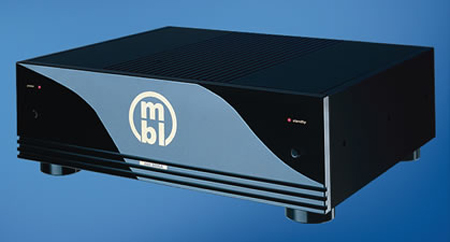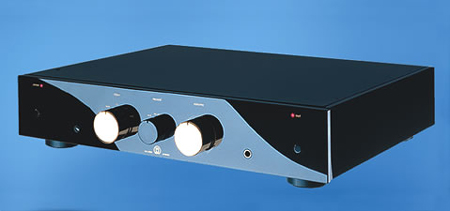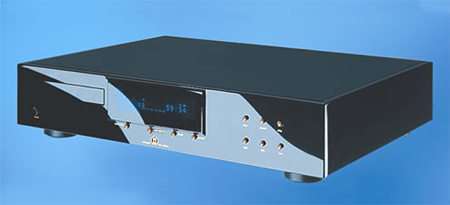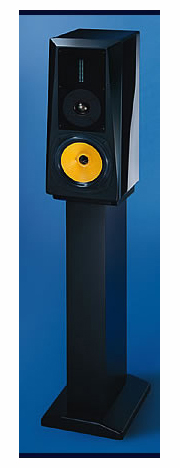You are reading the older HTML site
Positive Feedback ISSUE
16
november/december 2004
mbl
the Basic Line system
as reviewed by Larry Cox

|
LARRY COX'S SYSTEM LOUDSPEAKERS ELECTRONICS SOURCE CABLES ACCESSORIES
|
One of the benefits of reviewing is that—most of the time—you get to hear the equipment you want to hear, instead of what other people want you to hear. For the past five years, I've been reviewing only gear that I'm interested in, and to which I have already had some exposure, though usually not in my own listening room. If I weren't married, I would have stayed on that path, but my German wife recently asked me: "How come you never listen to equipment made in Germany?" She is an American citizen, but loves her native country. I've reviewed American gear, Swiss gear, English gear, and a few pieces of Italian gear, but not German gear, so trying something German seemed interesting.
The companies that came to mind were MBL, Avantgarde, and Burmester. I picked MBL, one of the world's premier companies, not just Germany's. On the MBL website, I discovered that MBL's U.S. distributor is Peter Alexander, who does business on that fabulously-named street, Sleepy Owl Way in Scottsdale, Arizona. Peter was very accommodating. I asked about reviewing an amplifier and Peter parried with, how about hearing an entire MBL system? He had the "Basic System" in mind, the German way of saying, "our entry level system."

MBL gear is not inexpensive. The Basic System, which includes the 8006A amplifier (top), 4004 preamplifier (above), CDP2 CD player (below), and 311 E stand-mounted loudspeakers, retails for about $16,000 sans cabling. The electronics sport acrylic black faceplates and gold knobs, but they are also available in "Arctic Silver." The build quality is typically German, which is to say very good. All of the pieces were quite heavy, which probably means that they contain beefy power supplies. Big power supplies usually mean good sound. Products without well-designed power supplies generally don't sound as good as those with them.

This will be a system review, rather than a blow-by-blow analysis of each component. I didn't have enough time to nail down the performance of each component in a variety of settings. It seems to me that every review is really a system review. You will never hear a turntable, for instance, without also hearing the arm and cartridge, and the same holds true for any component in a system.

Before I comment about the MBL system, I would like to disabuse an idea that many audiophiles, including me, tend to have, which is that if a component sounds a certain way on one system, it will sound that way in all systems. Mixing and matching components isn't like painting, where you know what you'll get when you mix colors. This was certainly the case with the MBL system. With the MBL electronics running my ATC speakers, the sound was dark and plummy. It was as rich in hue and color as any system I've ever heard. I liked it a lot. The density of musical colors was quite sensuous, and I was in a little bit of heaven until I switched back to my E.A.R. electronics, which were lighter in hue, and while they sounded less rich, they also sounded more realistic. The matching of the MBL components with my speakers yielded too much color and not enough light, although in a more reverberant room, it could have been ecstasy.
I then swapped the MBL 311 E mini-monitors for my ATCs, retaining my E.A.R. 509 monoblock amps and 864 preamp and my Audio Note 3.1x CD player. This provided a lighter, more forward sound than the MBL electronics running through the MBL speakers. Inserting the MBL CD player increased the system's warmth, richness, and bottom end fullness, depth, and speed. In this setup, the CDP2 was preferable to my reference player. In addition to the increased richness, the system's imaging was a bit more dense and rooted, despite the absence of my CD player's tube output stage.
The CDP 2 provides volume control on the output. I didn't notice this at first, as there is a volume control on the remote. I thought that it was interesting that MBL offered a preamp volume control on the CD remote, then I stumbled onto the truth of the situation. There's nothing like reading the manual! I'll learn someday. I'd say that the CDP 2 was the undisputed champion, and it should be, at a twenty-five percent higher price. My 3.1x is also slightly older, and in the digital world, time makes a difference.
The MBL 4004 A preamplifier ($2680) was quite good. With remote control for volume and source, I found it as easy to enjoy as it is to use. It lacked the liquidity of my E.A.R. 864, but this did not translate as background noise. Black backgrounds, coupled with an excellent, textured bottom end, made the 4004 A something to consider as an alternative to my tubed unit. Although it lacks my preamp's phono section, the MBL's remote control makes it tempting.
My ATC SCM 35 speakers are a bit less expensive than the MBL 311 Es ($4608 in piano black), though if the MBLs had another finish, the two speakers would be close to the same price. My reference speakers produced substantially more bass, with the ability to play much louder, but the 311 Es would be a much better match for smaller rooms, where my 35s put out too much bass. Even in my very large room, the 311 Es delivered plenty of bass, belying their small size. As you'd imagine, the much smaller MBLs imaged better than my reference speakers.
In comparison to my E.A.R. 509 tubed monoblocks, the $4416 solid state MBL 8006 A didn't fare quite as well, although given the fact that the current iteration of the 509s retail for $11,000, where's the surprise? The MBL's bass was slightly tauter than that of my reference amplifiers, but in every other area, I preferred the sound of the 509s. Nevertheless, the MBL's imaging was surprisingly three dimensional for a solid state amplifier.
A particular "German" style wasn't obvious from the Basic System. Rather, the system had a "Dragnet" style—just the facts, ma'am—with a slightly warmer-than-neutral presentation. Treble extension was greater than with some American products, but those products tend to emphasize treble more than is "correct." Image specificity and soundstaging were quite good, especially given the fact that there were no tubes in the system.
The Basic System performed well, with hardly an area of performance that stood out. The sound was much as you'd hope it was, after putting $16,000 on the line. For many, it will be worthwhile to trust a single manufacturer to create a complete system. Many audiophiles are reluctant to attempt putting components together to create a system. If you buy a complete system, you will have to give up mixing and matching and "being creative," but for many, this will be a relief. Do you actually like being on the merry-go-round of gear upgrades? There are a few companies that provide a quick route in and out of audiophilia, and MBL is one of them. Ensemble is another, although entry into the Swiss world will cost you $10,000 beyond MBL's Basic System.
The sound of the Basic System reminded me very much of the Audio Note Zero System. Although the Zero system retails for about one third of the price of the Basic System, both speak as one. Both are nimble, organic sounding, and of a piece. The Zero System sounds much more lightweight, but while the MBL system has far more foundation, it retains the speed of the English system. And while the Zero system is surprisingly good, it requires a small room. Not so with the Basic System.
The bass of the MBL 311 Es was less deep and weighty than my reference ATCs, which have usable output into the upper twenties in my room. I hardly anticipated that kind of bass from speakers as small as the 311s, and MBL states that they are 3dB down at 45Hz, but they were nearly sufficient for my 5500-cubic-foot listening room. Despite having rear ports, speaker placement was easy. They didn't have to be waaaay out in the room to sound their best, like the Verity Audio Taminos. Their bass performance was probably as good as it was because they present an inefficient, 4-ohm load, and efficiency is tied to bass production.
The sense of rolling motion that is necessary for realistic music reproduction was preserved. The Basic System allowed some of Tom Wait's disjointed noise/music on Blood Money to retain a rhythmic coherence that can easily dissolve when the bottom end is slow. The same was true for track 14 of Ensemble's Music in a Natural Perspective, which is even more "noisey" than Waits' music. The 311 E's did a more than credible job of maintaining rhythm, letting me hear the composer's intentions.
The imaging of the Basic System exceeded that of my own, allowing me to count violins during Vivaldi's Four Seasons. The swooping female vocals on the Indigo Girls' "Less Complicated" were nearly palpable, and tracking them was child's play. Israel Kamakawiwo‘ole's voice was precisely placed, with plenty of space for big IZ to occupy on "White Sandy Beaches," from his Facing Future. This was the kind of performance you should get from mini-monitors.
I found a couple of nits to pick, primarily because I was look for nits, not because they were glaring weaknesses. The midrange of the 311 Es stops short of transparency. On some recordings, at higher volume levels, there was a slight grittiness to vocals. As I pushed up the volume on Facing Future, there was a slight "screen door" effect on Israel's otherwise sweet, pure voice. It's not that the Basic System was closed in or rolled off, but exceptional products have an openness and refinement that not only invites closer listening, but almost unconsciously seduces you. Nevertheless, the Basic System was very good for its price, and I could easily and happily settle in with it in the long term.
Providing music moving on fast legs, with a full tonal balance, good imaging, surprisingly deep bass, and a capacity to fill a large room, the Basic System will fit easily in many rooms. If I were plunking down $16,000, I would not only want to enjoy the sound of the system, but to enjoy looking at it. The MBL system is sumptuous in appearance. The deep black acrylic faceplates provide a look commensurate with the cost of the units. I haven't seen the "Arctic Silver" models, so can't comment on them, but it's nice to have a choice. MBL gear isn't stocked everywhere, so you may need to do a bit of searching to see and hear one, but the quest will be worthwhile. Larry Cox
MBL
web address: www.mbl-germany.de
